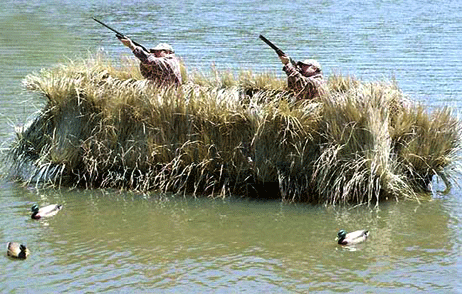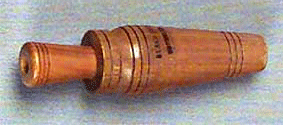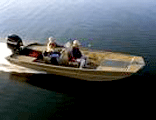Waterfowl Gear and Game Calls
Duck Blinds
The best way to outsmart a duck or goose is to climb into a blind. It gets back to the old adage: out of sight, out of mind. After that, it’s time for the seduction with decoys, calls and whatever other tricks that bring the wily birds into range.
While decoys and calls can be subjective, the blind is a proven practice for getting as close as possible to ducks and geese. Blinds are designed to camouflage hunters and avoid detection.
The best type of blind depends on the quarry and the hunting ground; but there is no shortage of choices. The hunter’s ingenuity, intuition and intelligence have created just about any kind of blind you need — including plans for building your own.
Mini-Barge Waterfowl Blinds
You’ll have duck blinds for grain fields, and duck blinds for marshes. A blind can be as simple as a bucket to park your butt and a camouflage tarp for concealment, all the way to the other side of the blind spectrum to a stealth mini-barge replete with cooking facilities and potties.
The climate will also dictate what type of blind that’s best for you. If you live in Michigan and hunt in the autumn, you’d definitely want a blind that can stand up to foul weather. Hunters in the south, by comparison, may opt for a blind that’s less expensive and portable.
Among the most important factors are your local hunting laws. Some states or counties require that your blind is removed at the end of the season. Partially submerged sinkbox blinds are illegal in the U.S. Before you climb into that tree and cover yourself with burlap, you may also want to check your local hunting statutes. And then again, some parts of the country outlaw only certain types of blinds.
Of course you can forego a blind altogether and use your waders or a skiff. But after a few seasons of that, you may opt for warmer and drier conditions and find yourself a good blind.
Effective Waterfowl Blinds
If that’s the case, there are several types of very effective blinds available to fit your hunting and budget desires.
A coffin blind is a one-man blind that consists of a set like a reclining lawn chair and shell. Situated among the decoys, birds can find these difficult to detect, especially under a layer of natural cover. When the birds get close enough, the hunter pushes open the top of the shell and starts shooting. Older and stouter hunters beware: sitting up fast may be a challenge.

A classic duck blind.
Sit-down blinds afford more comfort. Whereas the coffin blind is a single-hunter affair, these sit-down blinds can accommodate at least two people sharing a panorama view.
Backpack blinds can be carried in to your favorite hunting spot. The design on these varies widely. Some are cumbersome and heavy, while others are elegantly designed and a breeze to construct.
Floating blinds are basically small boats with camouflage. They’re great for hauling your gear. Some boats have cabins, others have pop-up blinds, while still others feature canopies against the elements. The 14-16-foot models are ideal for two hunters, and the boats can stretch upwards to 20 feet or more. Of course, you’ll want a trailer to haul around one of these puppies.
Permanent blinds are generally made of treated lumber built on solid uprights. Depending on its size, it can be the most comfortable of all blinds and certainly the easiest in which to swing your shotgun. The covering can be refreshed every year with a few limbs, branches and native grass.
Pit blinds may be more effective but they probably aren’t as cozy. Because with a pit blind, you’ve dug a hole and lined it with wood, fiberglass or concrete. And no matter what materials you use, this thing will flood. You’ll eventually have to pump. For hunting, though, the extremely low profile of a pit blind provides a good compromise: it lets you sit while concealing yourself from your quarry.
When it comes to blinds, the devil is in the details. Make sure your cover matches the natural surroundings. You also don’t want light to get through, revealing the profiles of the hunters. Make sure your portable blinds are easy to use and assemble.
If it means springing for a few extra bucks to get a significantly better blind, it may be the best investment you’ll make for waterfowl hunting. After all, consider that you’re trekking all the way out there. So don’t shortchange yourself.
While these impersonations won’t get you a gig in Vegas, they will bag you plenty of ducks and geese.
Duck and goose calls are designed to mimic the species, behavior and gender of your quarry — luring them within range for the kill. Alongside decoys, game calls are your basic enticements for waterfowl. The blind disguises your presence, but the game call gets their attention.

A Black Duck game call
Even though game calls are big business, the manufacturers give the impression of being small, cottage-industry aficionados. Each one seems to have the “perfect” call and will stake his reputation on it.
Likewise, avid waterfowl game callers enter high-stakes competition to settle, once and for all, who the heck has the best “lonesome hen” call in the universe. While these are the kinds of acts that could appear on a Funniest Video late-night TV show, the participants take these competitions extremely seriously.
Win $15,000 With Your Duck Call
The World’s Championship Duck Calling Contest is held every Thanksgiving weekend in Stuttgart, Arkansas. Contestants must work their way up state and regional competitions. The ultimate World Champion Duck Caller wins $15,000 — not exactly chicken feed.
As with other segments of the shotgun sports, waterfowl game calls have a rich tradition in craftsmanship and ingenuity.
The original duck-call patent of 1870 is held by Elam Fisher of Detroit. It consisted of a reed attached to a mouthpiece. Then Fred Allen of Monmouth, Illinois developed the first modern-style call in 1863 — giving rise to the basic two-part call of a stopper and barrel. The stopper contains the reed, wedge and toneboard.
Back then calls were made from a small wood block — typically rosewood, walnut or cedar. The block was turned on a lathe, and finished with a groove for the lanyard so that the hunter could wear it around his neck. Some duck-call makers turned them into gems of folk art with carvings and paintings made of exotic woods and trimmed with metal.
The Art of Duck and Goose Calls
If you think you can simply buy a call and attract hundreds of birds, you’d be dead wrong. That’s like thinking you could go out and buy a guitar and immediately become Eric Clapton. There is a real art to calling ducks and geese.
For one thing, you need to know the birds you’re calling. In essence, you need to think and vocalize like a duck or goose — in essence gain the confidence of the birds to attract them. The type of call you use depends on proximity, species, time of day, feeding patterns, season, wind — in short just about anything that affects the cycle of life in the wild.
For example, just between the ducks and geese you have the basic quack, the hail call, the feed call, the comeback call, the growl, cluck, murmur, honk, double clucks and moans. Of course, each call has its own subtleties.
The Best Way to Learn Duck and Goose Calls
So what’s the best way to learn a call?
Well, you can always go to Stuttggart, Arkansas and see the champs in action, or purchase a few DVDs. Several experts offer calling seminars.
When you’re buying a call, expect to pay between $20 and $125. Some experts will argue that a good caller could have just as good results with a cheap call as with an expensive one. While that may be true, the sheer abundance of call makers demands a real side-by-side comparison.
Some callers believe that wood produces a richer tone than acrylics or polycarbonates. Others will argue that the synthetic materials give you a more consistent tone, since wood tends to expand and shrink with moisture.
It would be a shame to spend all that money on waterfowl hunting gear, then expend a lot of time and energy getting to your favorite hunting spot, and simply lose the opportunity with a bad call. A little practice and dedication could give you stellar results.
Waterfowl decoys actually date back to ancient Egypt.
Tomb paintings revealed hunters using nets and boats, with other men holding decoys. The impression was that the hunters would sneak up on the birds through the thickets.
Today it is the hunters who remain still while the decoys do all the work — at least after the hunters go through the effort of setting up a spread. Then the wait begins and you join the long tradition of hunters who attempt to disguise their intentions.
Traditional decoys are made of cork or wood with plastic coming into its own. Their sole purpose is to float and attract the real thing. In conjunction with the blind and game call, the decoy spread lures the birds into range.
(For the record, hunting ducks in the field lets you use the less expensive and lighter silhouette decoys. You stake out the spread, with manufacturers providing many different postures. The only caveat here is to beware of glare that could spook the ducks, so look for non-reflective materials.)
Decoys in Different Species
Duck and geese decoys are available in just about any kind of species, since you want to make your quarry confident about landing within range. Now that you made the right purchase, the next big challenge is using your decoys properly.
The spread should both mimic the behavior of your quarry and put them within shotgun range. A well-placed spread will yield a robust harvest for your hunting party. Of particular importance is the number of decoys you use — since many hunters lean toward an over-abundance of decoys. And remember, more decoys means more hauling — and more time to set up and take down your spread.

Placement over volume is extremely important when it comes to the hunting competition. You don’t want to visually smother the birds, but rather catch their attention and get them to land. More often than not, that merely comes down to an expert spread. Part of that spread should include a landing zone, which typically consists of a 10-yard circle with an entry point. Pay attention to the wind, to see if your prey actually decoys into the wind.
Decoys and the Wind
Keep your back against the wind when you’re facing decoys. Duck and geese land into the wind, revealing their vital area for a clean kill. But if the wind shifts, you may have to move both your decoys and your blind.
Seasonality is critical for decoy spreads. For example, when you’re hunting later in the year you’ll need more decoys to lay out a spread that seems downright genuine. Again, though, if there are plenty of hunters in the area you may actually be better off with a small, strategically configured spread. Knowing your prey is the best way to achieve a highly effective spread.
But there’s another dimension of reality you need to give your spread — and that’s movement. Waterfowl create ripples. Given that they’re always paddling, preening and eating, it would be great if you could incorporate movement in your spread.
For traditional decoys, a simple piece of cloth on a stick could easily do the job. Called flagging, this technique gives your spread the illusion of movement. Then again, you can use a Robo Duk — at least that’s the name of one company that makes these battery-operated, animated decoys.
But are they too effective?
The state of Washington outlawed battery-powered duck decoys, claiming they are unsportsmanlike to the point of decimating waterfowl populations. Pennsylvania and California also banned the devices.
Even though they’re marketed under the names of RoboDuk, Mojo Mallard and WonderDuck to name a few, the effect is the same on the hunting community: polarization. You either love them for how effective they are, or you hate them in a way of being around people who use cell phones in public.
The crux of the argument against battery-powered decoys is a principle called “fair chase.” It stipulates that hunters should not have an improper advantage over their prey.
For example, in the 1930s Washington prohibited hunters from throwing food or tethering a live duck in order to lure other birds. Come the 1950s, Washington banned recording of live birds.
Has waterfowl hunting bumped up against the digital age? With cell phones in blinds, digital decoys and boom-box game calls, you may have to venture further and further out to find that unspoiled duck and goose spot.
When it comes to blinds, calls and decoys the common strategy is to lure your prey into range.
But sometimes you’ll just need to sneak up on those critters, and that’s where your favorite waterfowl boat comes to play.
Scan the marketplace for boats and you’ll find all kinds: canoes, stealth, jons, punts and even some innovate designs that incorporate the best of the most popular waterfowl hunting boats.

Best Selections Ever
While hunting for a waterfowl boat may make your head spin, the good news is that your selections have never been better. Advances in technologies, design and affordability put a good waterfowl boat within grasp of just about any hunter. Flat hulls, low center of gravity and materials such as aluminum, fiberglass and composites can make you a better hunter at the best possible price.
Camouflage techniques have truly reached a state of the art. And many boats are filled with handy features such as lockable storage, built-in fuel tanks, different seating configurations and stealthy silhouettes.
Motors have also benefited from advances in technology. Surface drive mud motors propel small boats across water obstacles, including sand, swamps, and weeds — the kind of natural impediments that would have stopped conventional motors dead in their tracks. Their advantage is in their simplicity. Mounted on long struts, they are air-cooled and generally feature only a single speed with no reverse. The long struts allow you to tilt the motor at almost any angle to accommodate the shallow surface.
You’ll Want Your Skags
The so-called skags around the propeller protect them from debris, automatically lifting the motor to safely clear the submerged obstacle.
With all the developments and competition, it’s almost impossible not to find the exact boat that fits your specific requirements. The bigger question then becomes: do you know what kind of hunting you’ll be doing with your boat?
One of the most important considerations is the terrain. Sure, tall reeds provide great hiding places, but you’ll also need a boat and motor capable of navigating that terrain. Hauling your boat over land or sand bars? Then you’ll definitely want a boat with handles and a flat, smooth bottom without welds that add drag.
And how many buddies will you hunt with? You’ll need enough room to safely sit your hunting party, but that means you’ll also have plenty of gear — plus your favorite dogs. So not only will you need more room, but also a bigger motor to handle the extra weight. Two hunters can get into a 12-foot jon boat with plenty of room for everything, but more than two people may cause you to bump up to a 16 footer.
Of all your requirements, safety of course is the most important. You need to make absolutely certain that the design of your boat ensures stability in the kind of terrain that you’ll be hunting in. That means, for example, the seating configuration in your boat should be able to accommodate comfortable and safe shooting to avoid standing in the boat. The instability of your boat could worsen if it’s overloaded, so you need to ask yourself if, in the interest of safety, you should step up to the next size boat just in case you have an unannounced shooting buddy at your doorstep.
It’s tempting to shortcut yourself on some hunting accessories, but a boat should not be one of them. Having the right boat can make the difference between making it back home at night or not.
And by the way, if for some crazy reason you don’t pack personal flotation devices on your boat, please make sure you can swim.
Useful links:
http://www.nrahq.org/hunting/statefishgame.asp

Irwin Greenstein is Publisher of Shotgun Life. Please send your comments to letters@shotgunlife.com.


Comments